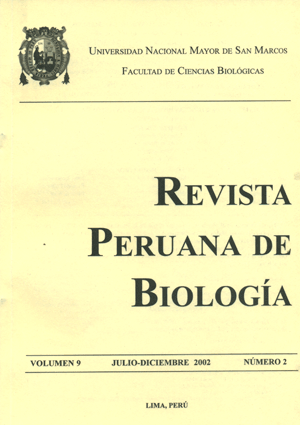Larvicidal effectiveness of the ethanolic extract of Annona cherimolia “cherimoya” Miller and A. muricata Linneaus “graviola” seeds against Anopheles sp.
DOI:
https://doi.org/10.15381/rpb.v9i2.2525Keywords:
Biopesticide, seeds, larval mortality, Anopheles, AnnonaAbstract
In view of the increase of the resistance produced by chemical pesticides used against mosquitoes as vectors of public health diseases, searching for alternative methods has begun by using plant extracts with larvicidal activity which are environmentally safe and biologically degradable. Under this premise, the aim of the present study was to evaluate the mortality on fourth stage larvae of Anopheles sp. by using ethanolic extract of A. cherimolia (E1) and A. muricata (E2) seeds. The bigger mortality percentages corrected by Abbott’s formula were 100% on the twelveth hour at 8,0 and 12,0 mL/100 mL concentrations in E1 and E2. Morover E2 reached more larval toxic effect than E1 in about 4,58% of mortality. The probit analysis showed an heterogeneous response of the larval individuals towards 50% (LC50) and 90% (LC90) lethal concentrations throughout the evaluation period, and an homogeneity response towards 50% (LT50) and 90% (LT90) lethal times when the concentrations of the extracts were increased. Likewise, the slopes of the log-dosage/probit lines showed larval individuals with different susceptibilities demonstrating the presence of different populations and gene compositions. The work allowed us to evaluate the efficiency of both extracts and to understand the necessity of more assays to ensure the best larvicidal control in such mosquitoes.Downloads
Downloads
Published
Issue
Section
License
Copyright (c) 2002 Miguel Bobadilla Álvarez, Gina Zavaleta Espejo, Fanny Gil Franco, Luis Pollack Velásquez, Manuel Sisniegas Gonzales

This work is licensed under a Creative Commons Attribution-NonCommercial-ShareAlike 4.0 International License.
AUTHORS RETAIN THEIR RIGHTS:
a. Authors retain their trade mark rights and patent, and also on any process or procedure described in the article.
b. Authors retain their right to share, copy, distribute, perform and publicly communicate their article (eg, to place their article in an institutional repository or publish it in a book), with an acknowledgment of its initial publication in the Revista Peruana de Biologia.
c. Authors retain theirs right to make a subsequent publication of their work, to use the article or any part thereof (eg a compilation of his papers, lecture notes, thesis, or a book), always indicating its initial publication in the Revista Peruana de Biologia (the originator of the work, journal, volume, number and date).






